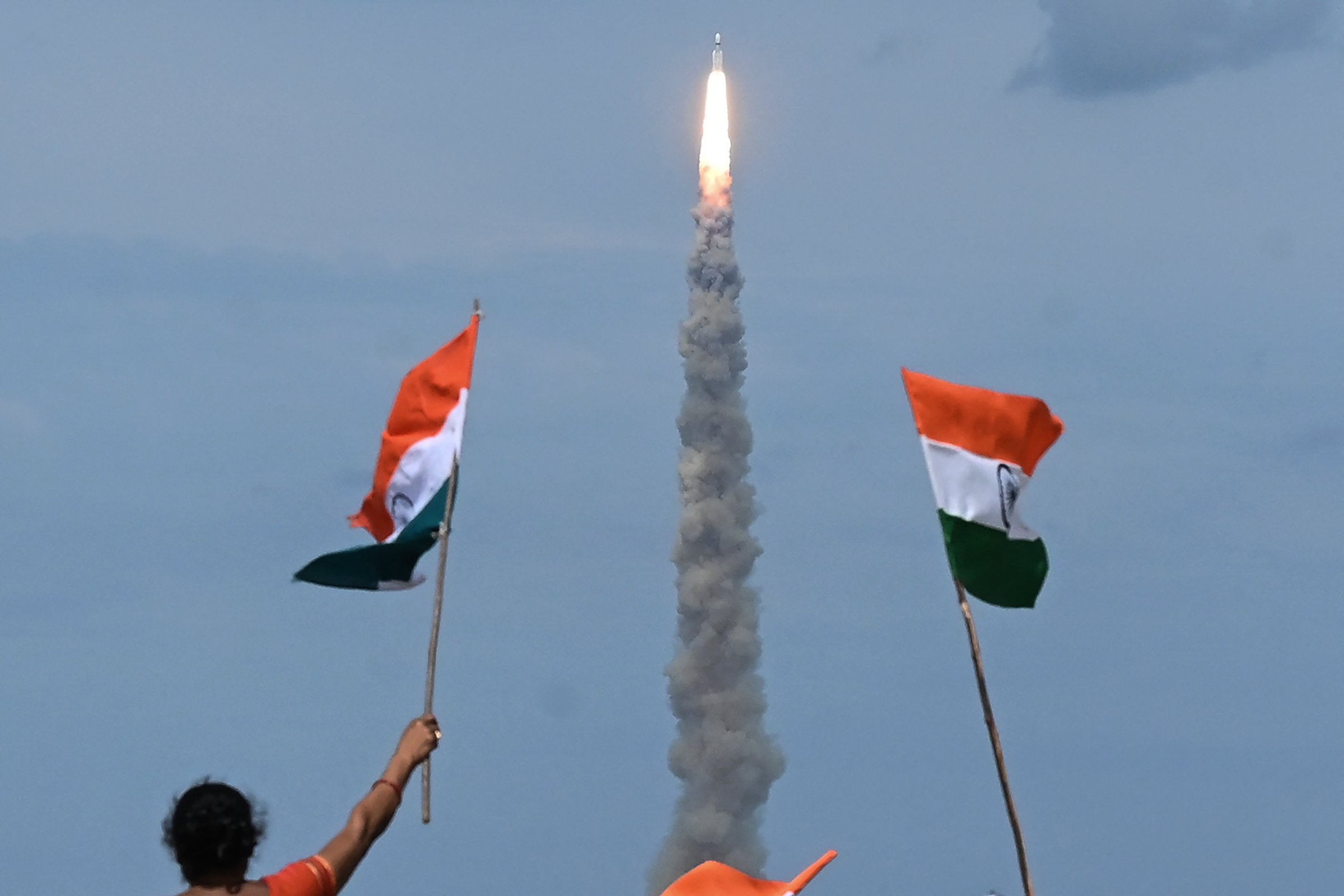
The viewer’s gallery of the Satish Dhawan Space Center in India was a noisy place at 4:05 a.m. ET on Friday morning, July 14. Cries of “Bharat Mata ki jai” (Victory to Mother India) filled the hall, as outside, at a distant launchpad, the engines lit on a 14-story rocket carrying Chandrayaan-3, India’s third spacecraft bound for the moon. The rocket flew true, and less than 15 minutes later, Chandrayaan-3—a combination orbiter, lander, and rover—was on its way on a month-plus journey that should have it reach the moon by August 24.
“Chandrayaan-3 scripts a new chapter in India’s space odyssey,” tweeted Indian President Narendra Modi. “It soars high, elevating the dreams and ambitions of every Indian. This momentous achievement is a testament to our scientists’ relentless dedication. I salute their spirit and ingenuity!”
As well he might salute them. The Indian Space Research Organization (ISRO), may not quite rival NASA, Russia’s Roscosmos, or the China National Space Organization for preeminence in the cosmos, but it is coming close. Since its founding in 1969, ISRO has launched 124 of its own spacecraft—including three to the moon and one to Mars; 15 satellites developed by Indian students; and 424 satellites by other countries paying to have their payloads launched atop India’s reliable boosters.
But it is the moon and Mars missions that have earned Indians the most pride—and the most headlines. The Mars Orbiter Mission—nicknamed MOM—was launched on Nov. 5, 2013, and entered Martian orbit on Sept. 24, 2014, marking India as the first country to successfully reach Mars on its first try. The mission, with a price tag of just $75 million, famously cost less than the production of the movie Gravity, which was released the same year as the spacecraft’s launch. MOM functioned in orbit for eight years—making continual observations of the Martian surface—before finally wearing down in 2022.
Chandrayaan-1, which was launched in 2008 and marked India’s first attempt to send a craft to another world, was by some measures a modest mission, a simple lunar orbiter rather than a lander, which lifted off more than 42 years after the Soviet Union’s Luna 10 became the first spacecraft to orbit the moon. But it’s not when Chandrayaan-1 got to the moon that put it in the science history books; it’s what it accomplished when it got there. The spacecraft, which operated in lunar orbit for two years, was the first to detect traces of water ice in the lunar regolith, or soil. What’s more, Chandrayaan-1 carried a 29 kg (64 lb.) impactor probe that was deliberately crashed into the lunar south pole, detecting water just before it hit. That discovery has had a profound influence on both the U.S. and Chinese space programs’ plans for crewed exploration of the moon: astronomers had long suspected that permanently-shadowed craters at the south lunar pole could hold abundant deposits of water ice, which astronauts could harvest for drinking water, oxygen, and rocket fuel. Chandrayaan-1’s discovery went a long way to proving those theories sound.
Chandrayaan-2, launched in July 2019, was not as successful as its older sibling. Consisting of an orbiter, lander, and rover like Chandrayaan-3, it was intended to touch down in the moon’s south pole—the first spacecraft ever to reach that region of lunar real estate. Like Chandrayaan-1, it successfully reached lunar orbit—and continues to operate there today. But its lander and rover, which separated from the orbiter and descended toward the surface, crashed just seconds before the conclusion of what had until that point been a perfectly controlled descent. The fault was ultimately traced to a software glitch in the lander’s braking system.
Chandrayaan-3 is, in almost all respects, a do-over of Chandrayaan-2—except with the software bug fixed. The orbiter, which weighs in at 2,148 kg (4,735 lbs.), serves principally as a delivery vehicle for the orbiter and rover and, paradoxically, carries no lunar observation hardware. Rather it is equipped with an instrument designed to use the spacecraft’s lunar vantage point to look deeper into space, searching for potentially habitable exoplanets.
The 1,752 kg (3,862 lb.) lander, by contrast, carries a suite of instruments, including ones to measure the seismic activity of the south lunar pole, track the temperature fluctuations of the region, and measure the pole’s plasma field. Also tucked aboard the lander is the little, six-wheeled, 26 kg (57 lb.) rover, which itself carries a laser spectrometer and an x-ray spectrometer, which will allow it to study the chemical and mineralogical composition of the regolith.
The lander and rover won’t have long to do their work. Powered by solar panels, they are designed to last just one lunar day—or 14 Earth days—before they plunge into the utter blackness and frigid -246°C (-410°F) temperature of the lunar night. Then, unpowered and forever still, they will become permanent cosmic monuments—both to the achievements of ISRO and to the ambitions of India.
More Must-Reads From TIME
- The 100 Most Influential People of 2024
- Coco Gauff Is Playing for Herself Now
- Scenes From Pro-Palestinian Encampments Across U.S. Universities
- 6 Compliments That Land Every Time
- If You're Dating Right Now , You're Brave: Column
- The AI That Could Heal a Divided Internet
- Fallout Is a Brilliant Model for the Future of Video Game Adaptations
- Want Weekly Recs on What to Watch, Read, and More? Sign Up for Worth Your Time
Write to Jeffrey Kluger at jeffrey.kluger@time.com